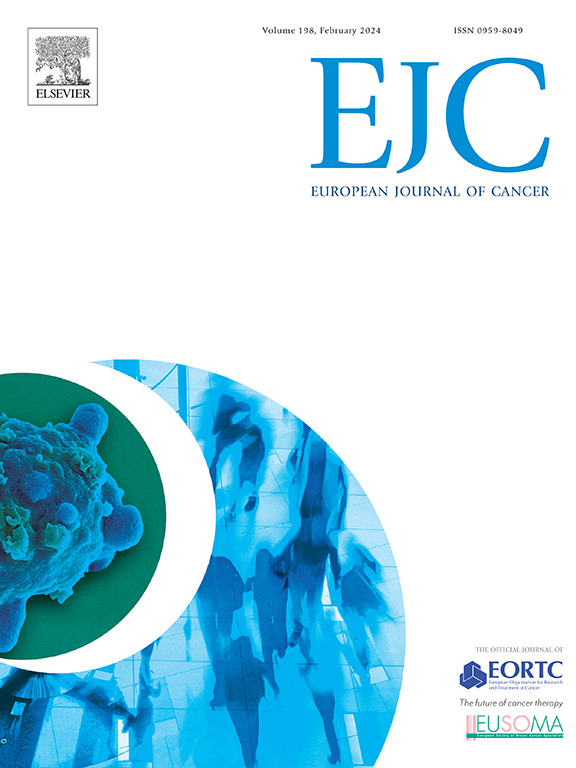Prognostic relation of body mass index on extended aromatase inhibition treatment in postmenopausal patients with estrogen receptor positive breast cancer: A retrospective analysis of the SOLE trial
IF 7.6
1区 医学
Q1 ONCOLOGY
引用次数: 0
Abstract
Background
Obesity is associated with a greater risk of developing distant recurrences in patients with estrogen receptor-positive (ER+) breast cancer. This association is however poorly investigated in patients treated with extended endocrine treatment (ET). We therefore evaluated the prognostic role of BMI in the SOLE trial, where postmenopausal patients, after having completed 4–6 years of adjuvant ET, were treated with 5 additional years of continuous or intermittent letrozole.
Patients & methods
We considered the 3606 patients with ER+ /HER2- lymph node-positive BC with available BMI from the SOLE trial (NCT00553410). Distant-recurrence free interval (DRFI) was the main endpoint, and breast cancer-free interval (BCFI), disease-free survival (DFS) and overall survival (OS) secondary endpoints. Adjusted risk ratios (RR) for distant metastases were estimated with crude cumulative incidence models.
Results
38.6 % of the patients were underweight or normal weight, 36.5 % overweight and 24.9 % obese. BMI was associated with age, tumor size, number of positive lymph nodes, menopausal status and type of prior ET. In the adjusted analyses, the prognostic value of BMI was dependent on prior ET and extended ET arm (second-order interaction p-value<0.001 for DRFI, BCFI and DFS, but not for OS). For instance, in patients treated with both a selective estrogen receptor modulator and an aromatase inhibitor in the first five years, obesity, as compared to normal-weight, was associated with better (RRDRFI=0.61, 95 %CI: 0.42–0.90) and worse (RRDRFI=2.31, 95 %CI: 1.41–3.78) outcomes in the adjusted models, in patients treated with continuous and intermittent letrozole in the extended ET, respectively.
Conclusion
We observed that the prognostic relation of BMI changes according to the type of adjuvant ET and mode of administration of extended AI. This warrants further investigation.
体重指数与绝经后雌激素受体阳性乳腺癌患者延长芳香化酶抑制治疗的预后关系:SOLE试验的回顾性分析
背景:雌激素受体阳性(ER+)乳腺癌患者的肥胖与远处复发的风险增加有关。然而,在接受延长内分泌治疗(ET)的患者中,这种关联的研究很少。因此,我们评估了BMI在SOLE试验中的预后作用,在该试验中,绝经后患者在完成4-6年的辅助ET治疗后,再接受5年的连续或间歇来曲唑治疗。的病人,方法:我们考虑了来自SOLE试验(NCT00553410)的3606例ER+ /HER2-淋巴结阳性BC患者。远处无复发间期(DRFI)为主要终点,无乳腺癌间期(BCFI)、无病生存期(DFS)和总生存期(OS)为次要终点。结果38.6% %的患者体重过轻或正常,36.5% %的患者体重过重,24.9% %的患者肥胖。BMI与年龄、肿瘤大小、阳性淋巴结数量、绝经状态和既往ET类型相关。在调整后的分析中,BMI的预后价值取决于既往ET和延长ET臂(DRFI、BCFI和DFS的二阶相互作用p值为0.001,但与OS无关)。例如,在前5年同时接受选择性雌激素受体调节剂和芳香化酶抑制剂治疗的患者中,与正常体重相比,在调整后的模型中,连续和间歇来曲唑治疗的患者分别与较好的(RRDRFI=0.61, 95 %CI: 0.42-0.90)和较差的(RRDRFI=2.31, 95 %CI: 1.41-3.78)结果相关。结论观察到BMI与预后的关系与辅助ET的类型和延长AI的给药方式有关。这值得进一步调查。
本文章由计算机程序翻译,如有差异,请以英文原文为准。
求助全文
约1分钟内获得全文
求助全文
来源期刊

European Journal of Cancer
医学-肿瘤学
CiteScore
11.50
自引率
4.80%
发文量
953
审稿时长
23 days
期刊介绍:
The European Journal of Cancer (EJC) serves as a comprehensive platform integrating preclinical, digital, translational, and clinical research across the spectrum of cancer. From epidemiology, carcinogenesis, and biology to groundbreaking innovations in cancer treatment and patient care, the journal covers a wide array of topics. We publish original research, reviews, previews, editorial comments, and correspondence, fostering dialogue and advancement in the fight against cancer. Join us in our mission to drive progress and improve outcomes in cancer research and patient care.
 求助内容:
求助内容: 应助结果提醒方式:
应助结果提醒方式:


